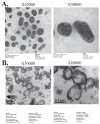Protective efficacy of an inactivated Brucella abortus vaccine candidate lysed by GI24 against brucellosis in Korean black goats
- PMID: 30670904
- PMCID: PMC6318821
Protective efficacy of an inactivated Brucella abortus vaccine candidate lysed by GI24 against brucellosis in Korean black goats
Abstract
The efficacy of GI24-lysed Brucella abortus cells as a vaccine candidate against brucellosis in goats was evaluated on 2 groups of Korean black goats. Group A goats were immunized subcutaneously (SC) with sterile phosphate-buffered saline, whereas group B goats were immunized SC with approximately 3 × 109 lysed B. abortus cells. Subcutaneous immunization with the lysed cells did not cause any negative impact on the overall clinical status, such as behavior and appetite, throughout the study period. The enzyme-linked immunosorbent assay (ELISA) optical densities values for B. abortus lipopolysaccharide in serum were considerably higher in group B than those in group A. Also, the levels of the cytokines interleukin 4 (IL-4), tumor necrosis factor-alpha (TNF-α), and interferon gamma (IFN-γ) were significantly elevated in group B compared with those in group A. Following intraconjunctival challenge with B. abortus strain 544, the severity of brucellosis in terms of infection index and colonization of B. abortus in tissues was significantly lower in group B than in group A. The present study concluded that 3 of 5 goats immunized with GI24-lysed bacteria were completely protected against challenge. Future investigations are required to improve the protective efficacy offered by lysed B. abortus cells for practical applications in small ruminants.
L’efficacité de cellules lysées de Brucella abortus GI24 comme vaccin candidat contre la brucellose chez les chèvres a été évaluée chez deux groupes de chèvres noires coréennes. Les chèvres du groupe A ont été immunisées par voie sous-cutanée (SC) avec de la saline tamponnée stérile, alors que les chèvres du groupe B ont été immunisées SC avec environ 3 × 109 cellules lysées de B. abortus. L’immunisation sous-cutanée avec les cellules lysées n’a pas eu d’impact négatif sur l’état clinique général, tel que le comportement et l’appétit, tout au long de la période d’étude. Les valeurs de densité optique obtenues lors d’épreuves immunoenzymatiques (ELISA) utilisant le lipopolysaccharide de B. abortus étaient considérablement plus élevées avec le sérum des animaux du groupe B que celui des animaux du groupe A. De plus, les niveaux des cytokines interleukine-4 (IL-4), du facteur-alpha nécrosant de tumeur (TNF-α), d’interféron-gamma (IFN-γ) étaient significativement plus élevés dans le groupe B comparativement au groupe A. Pour donner suite à l’infection-défi intra-conjonctivale avec la souche 544 de B. abortus, la sévérité de brucellose en termes d’index d’infection et de colonisation des tissus par B. abortus était significativement moindre dans le groupe B que dans le groupe A. La présente étude a permis de conclure que 3 des 5 chèvres immunisées avec les bactéries GI24 lysées étaient complètement protégées contre l’infection. Des études ultérieures sont requises pour améliorer l’efficacité protectrice offerte par les cellules lysées de B. abortus pour une application pratique chez les petits ruminants.(Traduit par Docteur Serge Messier).
Figures




References
-
- Bano Y, Lone SA. Brucellosis: An economically important infection. J Med Microb Diagn. 2015;4:208.
-
- Leal-Klevezas DS, Martínez-Vázquez IO, García-Cantú J, López-Merino A, Martínez-Soriano JP. Use of polymerase chain reaction to detect Brucella abortus biovar 1 in infected goats. Vet Microbiol. 2000;75:91–97. - PubMed
-
- Cutler SJ, Whatmore AM, Commander NJ. Brucellosis — New aspects of an old disease. J Appl Microbiol. 2005;98:1270–1281. - PubMed
-
- Pappas G, Akritidis N, Bosilkovski M, Tsianos E. Brucellosis. N Engl J Med. 2005;352:2325–2336. - PubMed
Publication types
MeSH terms
Substances
LinkOut - more resources
Full Text Sources
Research Materials
